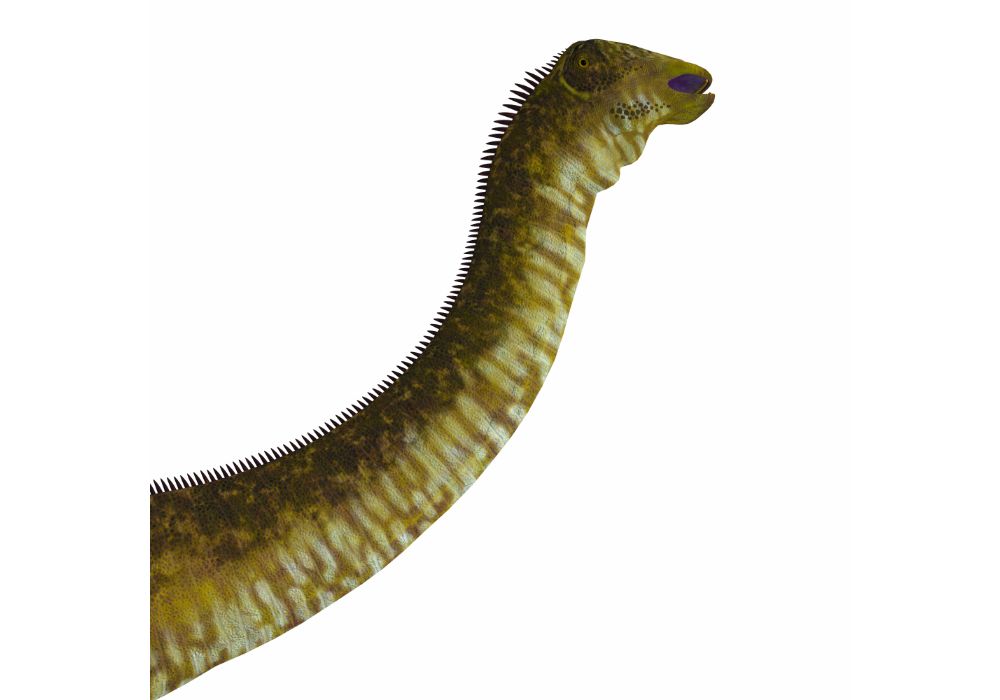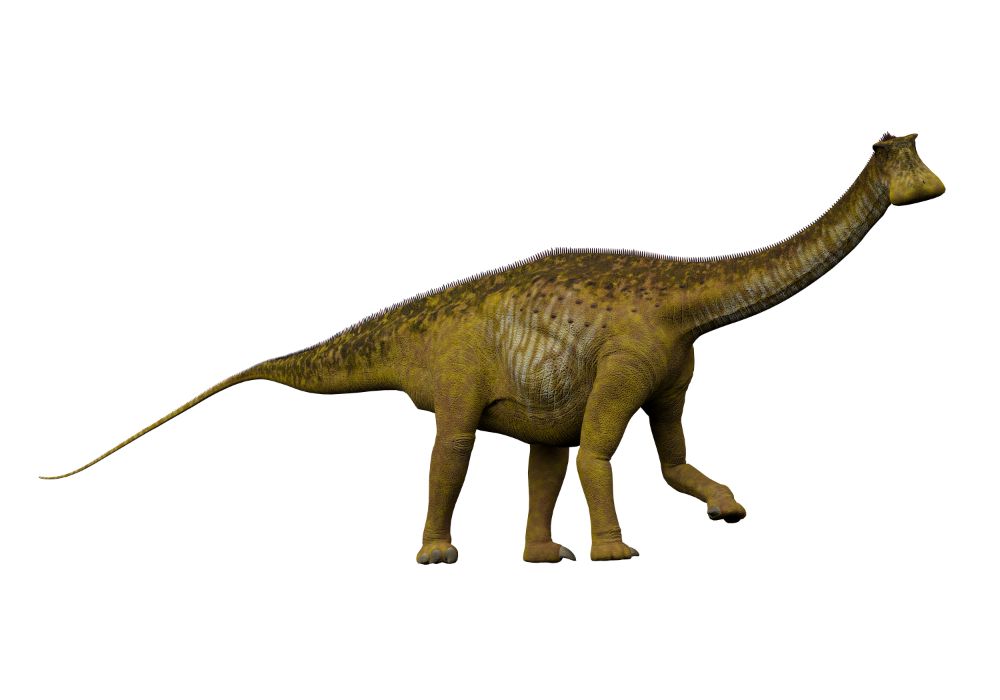Dinosaurs are perhaps one of the most fascinating creatures to ever exist. With massive limbs, unique vertebral columns, and bird-like heads, these prehistorical beings dominated the planet for millions of years, living both on land and at sea.
Sadly, a mass extinction event that happened 65 million years ago wiped them out. But all is not lost! These massive and terrifying creatures left their mark on Earth in the form of distinctive footprints and fossils.
By studying these, paleontologists have successfully uncovered adaptations that allowed dinosaurs to thrive in the Mesozoic era. One such adaptation is their many sharp teeth used for foraging, hunting, and defense.
On that note, today we will answer one of the most popular questions: What dinosaur has 500 teeth?
So, join us as we unravel the mysteries of the dinosaur with the most astounding dental count.
The Dinosaur with The Most Teeth: Nigersaurus
Before September 2019, only a few people knew about Nigersaurus, a large sauropod dinosaur first discovered in the dunes of the Sahara Desert.
However, this elephant-sized creature came into the limelight, when an internet joke turned into a meme got posted and shared on Reddit by Juvenile Jokers.
Sadly, the joke, which read “whatever you do, don’t google dinosaur with 500 teeth” was a racial slur. It was meant to shock gullible internet users by recommending a name similar to the N-word.
Nevertheless, we will not focus so much on the insensitive joke, but rather on the amazing creature it highlights: the Nigersaurus taqueti.
What Was Nigersaurus
The Nigersaurus belonged to the genus of the sauropods, a group of dinosaurs that had long necks, small heads, long tails, and large bodies. But the Nigersaurus had a shorter neck compared to the other sauropods.
Also named the Mesozoic cow, Nigersaurus lived during the early Cretaceous period, about 121 -99 million years ago. It gets its name from the Republic of Niger, where it was discovered in the 1970s. Its name also translates to the Niger reptile or Niger lizard.
As for the name “taqueti”, it refers to the sub-species of the Nigersaurus. It also pays homage to Philippe Taquet, a French paleontologist who uncovered the first remains of this dinosaur during his expedition in Niger in 1976.
However, the complete fossils of the Nigersaurus were discovered by American paleontologist Paul Sereno in 1999.
So, what made this dinosaur so unique?
Well, you guessed it right! The Nigersaurus stands out for its unique set of 500 teeth, specialized for grazing on low-growing plants. But more on that in the section below:
Nigersaurus Teeth

Nigersaurus possessed a unique dentation structure, featuring over 500 teeth. Coupled with its broad mouth, this dinosaur could graze for food more effectively in the broad expanse of the Sahara Desert.
Paleontologist Paul Sereno compared the dinosaur’s distinctive facial structure to a modern vacuum cleaner. Scientists later proved Sereno’s observation after the reconstruction of the Nigersaurus skeleton.
Here’s the interesting part:
This dinosaur had a wide, shovel-like muzzle, specialized for grazing on low-lying vegetation. The elongated snouts featured four large fenestrae, which included 500+ small peg-like teeth.
Surprisingly, these teeth got replaced after 14 days.
Without a doubt, Nigersaurus rocked an extraordinary tooth structure. The dinosaur’s teeth were arranged in rows and stacked together in the jaw. As a result, they formed dental batteries, a group of neatly packed replaceable teeth.
While dental batteries proved common in beaked herbivores like triceratops, only a handful of sauropods had them.
Nigersaurus Dental Arrangement
As for the dental arrangement, this dinosaur had 60 columns of tiny, sharp teeth on the top jaw and 68 columns on the bottom jaw.
The full set of columns amounted to more than 500 teeth, with 9 sets of replacement teeth. The replacement sets ensured the creature had a constant supply of sharp teeth.
Another thing, the dinosaur’s teeth organization allowed for effective feeding, especially on fibrous plant materials. How? Well, the dinosaur engaged the outer rows during feeding, while the inner rows got replaced with a new set.
Before moving on, we have to highlight the Nigersaurus teeth orientation. These teeth extended laterally at the front of the dinosaur’s mouth, allowing it to feed on ground-level plants.
Let’s also not forget the Nigersaurus’s wide u-shaped lower jaw. The jaw acted like a lawnmower or a rake, allowing the animal to feed effortlessly, stripping vegetation from plants.
Overall, the dinosaur’s numerous teeth, wide muzzle, and specialized jaw design play a crucial role in its survival and success as a herbivore.
What Did Nigersaurus Use Its 500 Teeth for?
Nigersaurus’s exceptional dentation allowed it to feed in a way unique to other sauropods. Unlike its relative, it could not strip away leaves of high-growing plans.
While this might seem like a disadvantage, it’s not. The Mesozoic creature adapted to grazing on low-growing vegetation like horsetails and ferns, thanks to its short legs and long neck. The dinosaur didn’t need to spend much energy to move its large body around.
But wait, there’s more. Paleontologists say Nigersaurus had a lighter skull, which enabled it to feed for long periods without tiring.
The dinosaur also used its wide, shovel-like muzzles and rake-like teeth to scoop and eat the leaves and stems of multiple low-laying plants. Therefore, the animal could process large amounts of vegetation in their lush environment within a short period.
Nigersaurus relied entirely on plant material for survival. And thanks to the rapid tooth replacement, this creature could withstand wear and tear caused by grazing on tough vegetation.
Like other dinosaurs, Nigersaurus impacted the local ecosystem significantly. It shaped the vegetation structure in its habitat, influencing the distribution of abundant plant and animal species.
Interesting Facts About Nigersaurus

1. Skull and Air Pockets
Some paleontologists believe the bones of this dinosaur, which included air pockets, helped it to breathe. However, it’s hard to prove this statement, considering there are no tissues from the animal we can study.
Modern birds possess an advanced respiratory system, consisting of air pockets and a lung that allows air to flow in one direction.
This adaptation enables birds to receive oxygen constantly, even when inhaling or exhaling. And thanks to this specialized breathing system, birds can fly, keep their bodies light and regulate their body temperature.
Similarly, Nigersaurus bones, particularly it’s head and backbones, exhibited air-filled spaces. This observation gave rise to the theory that the dinosaur and modern birds possibly shared the same breathing system.
If this holds, it means Nigersaurus excelled at controlling its body temperature and staying light. But still, there’s a need for more research.
2. Discovery
We all know Africa is the cradle of mankind. But what if it’s also the cradle of dinosaurs?
Scientists believe the Nigersaurus originated from Central Northern Africa. This rings true, considering the animal’s remains were first discovered in Niger in 1976.
Paleontologists also discovered several postcranial bones in Algerian and Tunisia. Recently, the bones of the creature have been uncovered within the Elrhaz Formation in Gadoufaona, an area of Central Niger.
However, the dinosaur only got its name in 1999 after experts unearthed complete fossil specimens.
3. Posture
Over the years, experts have debated whether the Nigersaurus held its head high or lowered its skull. According to paleontologist Paul Sereno and his co-worker, the dinosaur positioned its snout at an angle of 67 degrees at all times to facilitate seamless foraging.
But some scientists disputed this hypothesis, suggesting that Nigersaurus enjoyed a wider range of motion, thanks to its vertebrae. That means the dinosaur could adjust its head position as fellow sauropods.
4. Size
Sauropods are among some of the largest creatures to walk the planet. However, the Nigersaurus didn’t boast a huge size like its relative. Instead, it weighed approximately 4 to 5 tons, similar to an African Elephant.
Besides that, this small giant had a tiny skull, a prominent tail, and thick hind legs. It also had a body length ranging from 9 to 10 meters or 30ft.
Another fascinating feature of the Nigersaurus is its unusually lightweight skull. It had a hollow structure and lots of openings, which reduced its weight. This allowed the Nigersaurus to move its head and neck more easily while foraging for food.
Experts believe the lightweight skull enhanced the dinosaur’s agility and maneuverability.
Closing Remarks
Nigersaurus, discovered in the Republic of Niger, was an ancient marvel that pushed the boundaries of dental adaptation.
With 500+ tiny, needle-like, and sharp teeth, the dinosaur successfully stripped the leaves and stems of low-lying plants like ferns and horsetails.
These teeth were arranged in 60 columns on the upper jaw and 68 columns on the lower jaw. They also got replaced every 14 days, ensuring the dinosaur had a constant supply of teeth.
Besides the 500 teeth, Nigersaurus also had a wide muzzle and specialized jaws, which came in handy during feeding. Furthermore, it had a lightweight skull and long neck, enhanced maneuverability, stability, and agility.
Are you interested in seeing the fossilized remains of this majestic Mesozoic beast? You can stop by the National Geographic Museum in Washington and Japan. The remains include the skull and all 500 teeth of the Nigersaurus.
If you have any questions, leave a message below!






